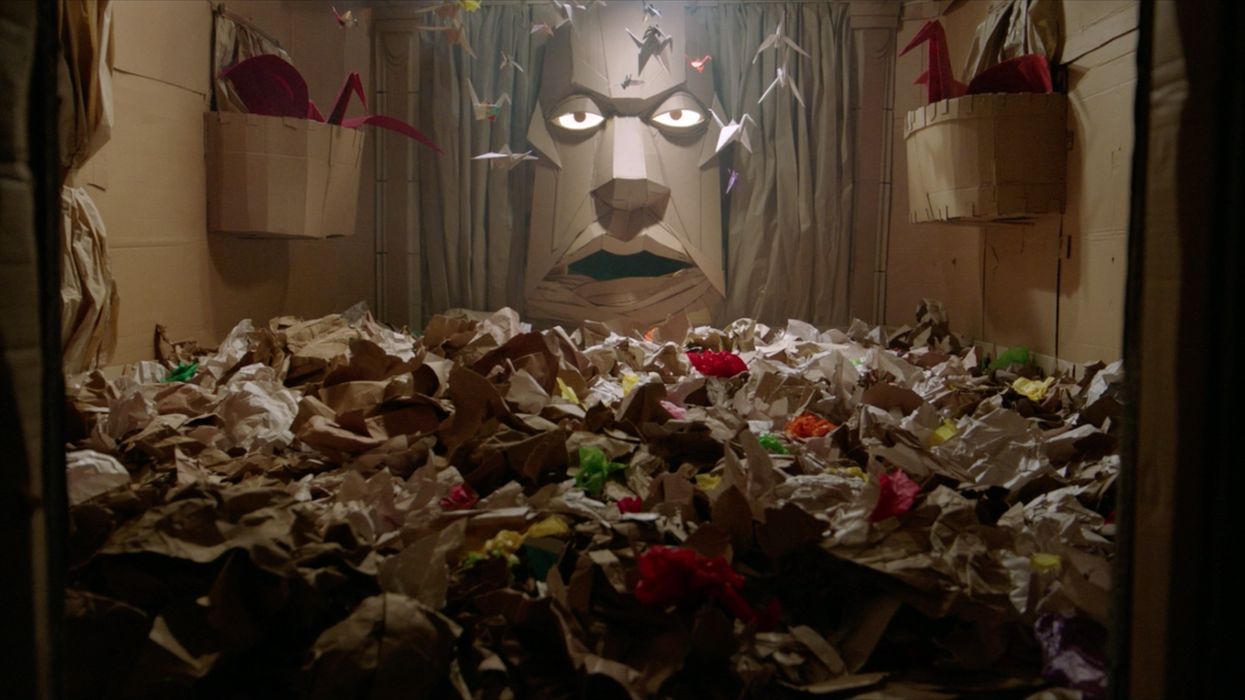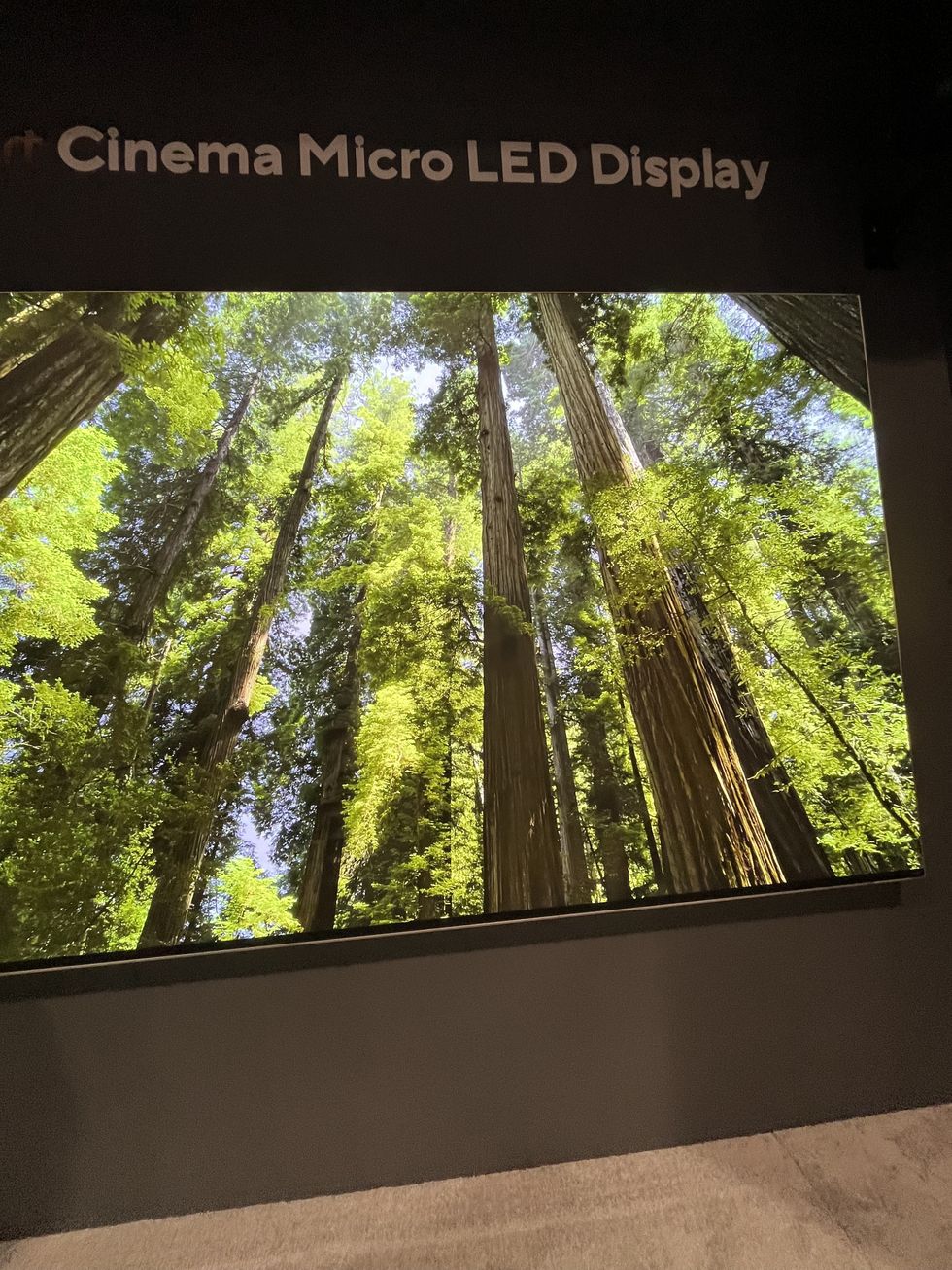Slamdance Audience Award Winner 'Dave Made a Maze' Was Inspired by an Epic Pillow Fort
"If you don't have hot glue gun scars on your hands, you didn't work on this movie with us."

After years of frustration as filmmakers and actors, Bill Watterson and Steven Sears decided to take matters into their own hands. Inspired by a story from Watterson's youth, Sears started writing the first draft of a script they would eventually co-write, and Watterson would direct, to become this year's Slamdance Audience Award winner: Dave Made a Maze.
The film tells the story of Dave, who never finishes anything yet somehow builds an epic labyrinth out of cardboard in his apartment, then gets lost inside of it. When his girlfriend Annie comes home, she urges Dave to come out of the maze, but he can't. Despite Dave's protests, a group of their friends (including a documentary filmmaker and some complete strangers) show up at their apartment and venture inside his crazy creation to rescue him. Unfortunately for them, Dave may have set some booby traps along the way.
No Film School had the opportunity to talk with Watterson and Sears about how their creative struggles inspired their imaginative film, building the intricate cardboard sets to create their handmade world, and discovering the joyous comedy in moments of sheer terror.
NFS: As I watched your film, the first thing that popped into my mind was, "You guys must have built some pretty epic forts in your youth."
Bill Watterson: That's a fact. Actually, the movie is born out of that. I was telling Steve, I built a pillow and blanket fort in my bedroom, and it was epic. I mean, it had chambers. It was the best fort I've ever built and you could just wander, and be like, "Oh, it feels different in this part of the fort." It was just great.
Then I left the house to go to a friend's house for dinner. I left a note for my mom, "I'll be at John Richards' house on Bennington for dinner, I'll be back." She comes home, doesn't see the note, starts calling my name, doesn't get a response, goes upstairs, opens the bedroom door, sees the fort, freaks out that I've gotten lost. That's how good it was, by the way.
Completely freaked out that I had gotten lost inside it, she tore the thing down looking for me before coming to her senses. I tried to rebuild it, but it was never the same. I told Steve that story, and three days later, he had a 60-page draft.
NFS: Wow. That's fantastic. That brings me to my next question.
Watterson: "Is your mom crazy?"
NFS: No, although I can see how it was an impetus for the story. But there's a lot more to the film in terms of struggling with finishing projects and creative endeavors. Can you tell us where you were creatively when you came up with this concept and then decided to pursue it as a feature-length script?
Steven Sears: Honestly, we were both kind of in a shitty place in terms of struggling in LA, but both of us really wanted to make something. In terms of creating something and writing, I feel like that was just born out of a lot of frustration. Not just in not being able to finish things, but feeling like doors are always being closed in your face, or getting close to something and feeling like you couldn't really get to the next level.
"We gave ourselves permission to make something."
I was working in post-production reality TV at the time, transcribing hours and hours of interview footage, really banal content. I felt like, "I want to work on something that I want to see, and also I want to tap into the frustration of feeling like you're not allowed to make something." Getting to work on this with Bill, we gave ourselves permission to make something.
Watterson: I had a similar background of bands that broke up just after we finished recording the record that never came out. Or songs that got half-written that I gave up on. Or scripts that hit walls and I didn't have the guts to climb over them.
I think it's a mistake to think this way, but you end up feeling like you need permission, you know? Steve and I are both actors as well, so there's a lot of, "Can I play too? Can I play too?" "No, you can't." "Okay, I guess I'll just go fuck myself." You know?
It hurts a lot and you have all this energy, you have all this stuff you want to say, and you get this feeling that you're not being allowed to say it, which is unhealthy. But that's what making the movie was so cathartic for addressing.

NFS: From that first 60-page draft of the initial idea to the finished film, how long did the process take?
Watterson: About five years total. We had a lot of time to hone the draft, and meanwhile we were attaching talent in front of and behind the camera based on all of our relationships as actors, improvisors, from working in the film industry. We started getting people attached who would be attractive to investors, started introducing ourselves to people that we were targeting as potential investors who would be excited about what we were doing.
"We said, 'Get it in the can quickly before anyone notices what we're doing, and then figure the rest out later.'"
Then probably three or four years after that initial draft, we got enough money to get it in the can, but not enough for post-production. We just made the call, we didn't really have enough time for pre-production, but we had this window of the key creatives' availability, and enough money to get it in the can, so we said, "Get it in the can quickly before anyone notices what we're doing, and then figure the rest out later."
We shot 20 days of principal photography in May 2015. We had four days of pickup shoots spread out over the next 18 months. Some of the stuff was actually finished in terms of the sound design and score being mixed and married to the final color maybe ten days ago?
Sears: I think it's worth noting in terms of pre-production, it was all hands on deck once we started going. I was building sets. Bill, you were painting an apartment set.
Watterson: Yeah, if you don't have hot glue gun scars on your hands, you didn't work on this movie with us. We'd see each other in bars, lift up our sleeves, show each other glue gun scars, and just nod knowingly.
"Once they read the script, everybody said, 'You're making a movie about me.'"
NFS: The sets made mostly out of cardboard are fascinating, but it sounds like a lot of you had to jump on board to get them done. How did you work with your production designers Trisha Gum and John Sumner to build these sets to match your vision?
Watterson: It was nuts and I still feel guilty that I didn't have more pre-production time, more funds available for that whole team. What helped immensely, first of all, Trish and John have a long-standing relationship, and Trish's then-boyfriend, now-fiancé, Jeff White, was our on-set art director who executed a lot of it. Jeff also got an additional production design credit because he was doing a lot on the fly. What really helped was they had a pre-existing working relationship. Sumner himself is a fine artist who works in cardboard, so he was particularly inspired.

Once they read the script, everybody said, "You're making a movie about me." They responded to the heart of the movie, the core, what you talked about as those incomplete projects. They not only tapped into the fundamental heart of the movie, but they also were custom-made for that aesthetic. All the references that we talked about in terms of forced perspectives, German expressionism, Michel Gondry, along with the low budget, were baked into the production design. For the story, it was supposed to be messy, hand-made. Raw. Incomplete. It still takes an artist's hand to make that look as good as it does in the film.
"Everyone was like, 'We have to finish this set because it's shooting in 15 minutes.'"
We also were lucky enough to work with Mike Murnane from the Cardboard Institute of Technology, who came down from San Francisco and was our lead sculptor. He built the Minotaur head. It was a playground for him, it was a sandbox. I think that was essential because if everyone wasn't so inspired and excited, no one would have survived the process.
We only had the physical space for two sets to be up at any given time. It was all on a sound stage in Glendale. If you watch any of the dailies, every single time you hear me call, "Cut," instantly there's like 20 people and sawdust falling from the ceiling. It was nuts.
Sears: It was working between the cracks. Between takes, it was trying to build as much as you could. We would still be building sets when they were doing closeups of somebody, like we would be building the sets that would be directly opposite them.
It was really last-minute stuff, but it was really like, "We gotta do this now, it's gotta go today." That really ramped the energy up. Everyone was like, "We have to finish this set because it's shooting in 15 minutes."

NFS: How did that impact how you put together your shooting schedule?
Watterson: I still don't understand how our AD Alexander Armero pulled off that schedule. We only went into actor overtime maybe twice? Which means we only had that principal cast for eight hours a day. We had an ensemble cast, and we only had 20 days. I still don't get it. Jeff knew ahead of time, "Okay, if we shoot this out, I can be building this, and then when we go to shoot this, I can repurpose that." He definitely had a master plan in his head that was communicated to production.
NFS: Your film has some of the funniest death scenes that I've ever seen. How did you guys come up with the rules of your world to put your characters in real danger, and yet visually, keep your audience laughing?
Watterson: It's very insightful, and I'm really glad that that's your takeaway from the film. I can't say that it's something I've necessarily thought too much about. I think it's a combination of a few things. Earlier versions of the script were much more horror-comedy. It was like fountains of blood. At some point not too far from the pre-production process, it changed. I don't remember where the idea came from, which is one of the things I love about this movie, it's like, "I don't know. It's there. I don't know."
The idea was to make the gore artisanal craft. Like confetti, silly string, all that stuff. It made perfect sense in the world because there is such a massive suspension of disbelief from the first line of the script. If you believe that Dave is in the maze, but can't get out, then you're like, "Well, now we can kind of do anything." Once you're talking about an entirely paper/cardboard/handmade craft-hour world, why not go all the way? Why not have that apply to everything that happens?

That felt like a moment that everything locked in. It made it more playful, it made it more surreal. It didn't make it any less impactful, but it kept you in this magical world of, "What is going on?" Which is where we wanted everyone to be, including the main characters. "What is going on? How is this possible?"
Then I think the third element is casting. I think we just really lucked out with an ensemble. We did not have table reads, we didn't have chemistry reads. All the roles were offer-only. We were just lucky enough to work with people who got it right out of the gate. Understood the tone, committed to the tone. Without hamming it up or without making it too dark. They just toed that line brilliantly.
"You need to write yourself into a corner, you need to give yourself a problem to work your way out of. "
NFS: There's a scene just before your climactic sequence that I thought was really unique, between the main characters Dave and Annie. The scene repeats itself with the same dialogue, but it has completely different meanings as it repeats. How did that scene come about in the writing process?
Watterson: I always felt like that scene was my baby. Steve had something in there where they're tunneling [through the maze], and then all of a sudden they're back in the apartment, and everything's changed and weird. That was always in there. I never quite understood it. I knew that it was gold, but I didn't quite get it, I couldn't explain what it was, and I knew I couldn't direct it, because I didn't know exactly what was happening.
I drove out to Claremont to do some writing in the public library, and I remember finally being like, "Oh, God, I get it. It's like one of those Hal Hartley moments, when characters are saying the same lines of dialogue, but they have utterly different meanings because of context and tone. We're gonna actually play out the whole course of a relationship, the good and the bad, in cycles, and they're gonna say the exact same thing to each other each time. The first time, it's clear that they're about to break up and they're at each other's throats. The next time, it's the same dialogue, but it's flirtation, and they're enjoying each other and getting to know each other. Then the third time, it's pure love and nothing is gonna stop them. They're truly a team now."
NFS: All filmmakers can relate to the struggle of trying to create something original and feeling like there are times when we can never finish anything. Besides just purely enjoying your film as they watch it, do you have any messages for the creatives out there that you want them to take away from your film?
Sears: I'd say make something. You have to make something. You have to kind of get screwed. Not by the world around you, but you need to write yourself into a corner, you need to give yourself a problem to work your way out of. I think that's what I've been realizing in the last couple of weeks is you need to put yourself in a creative bind, so you can really get creative to get out of it. Find a good team. People you trust. People with different ideas that you trust, so you can grow.
"No one is stopping you from making a movie."
Watterson: No one is stopping you from making a movie. I'm not a rich kid, I'm not [some celebrity's] son. No one is stopping you from making a movie. That doesn't mean it's easy, and doesn't mean you can do it on your own, but it's a fact.
Reiterating what Steve said, for us, team was everything. Every time a new teammate came on board, we felt more and more like, "Oh, this is possible. This is possible." Increasingly, "I have a responsibility. I have a responsibility to stick this landing."
Also, I think that the movie works because I kept a relatively small council, but I was always willing to defer to the best idea. It didn't have to come from me. A good idea is a good idea. A good story moment is a good story moment. Get out of the way. Get out of your own way.
I think that's what happens to a lot of us. It's like, "No, I'm working on it, I'm working on it. Yeah, it's really good, it's gonna be great." You know that if you show it to somebody, they have the opportunity to say, "This isn't great." That doesn't mean it can't be great. I mean, our first couple of screenings of this movie to a group of friends broke my heart. Because they had two hours of notes of all the stuff that didn't work. If we didn't show it, and I didn't listen, we would've made a far inferior movie.
Featured image: The origami swamp from 'Dave Made a Maze'. Courtesy of the filmmakers.














